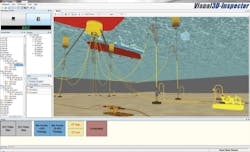Hidden integrity threat looms in subsea pipework vibrations
Rob Swindell
Xodus Group
Integrity is a constant concern for offshore oil and gas operators as assets continue to age, and it is being factored increasingly into the design of new installations in an effort to ensure that systems are reliable.
While many aspects of subsea equipment integrity are addressed at the design stage, vibration-induced fatigue is typically further down the agenda. However, failures of this nature can be catastrophic and result in complicated, expensive repairs. Operating experience shows that until around three years ago no significant issues had been experienced, but now that picture is changing. While the likelihood of a vibration-induced fatigue failure is small, the potential overall risk and impact can be significant.
Incidents of subsea failure have led to companies investigating this realm of integrity management. In the last four or five years, Xodus' vibration engineering team has seen work jump from virtually zero to around 50% of its business.
One problem with vibration-induced fatigue on subsea piping systems is that it is a "hidden" threat, as generally there is no indication topsides of vibration subsea. The only possible exception is flow-induced pulsation from a riser, sometimes known as the "singing riser" phenomenon, which may be heard topsides.
Experience on topsides facilities shows that vibration-induced fatigue can lead to pipework failure and subsequent hydrocarbon release. According to the UK Health & Safety Executive, up to 21% of topside pipework failures are caused by this type of issue, largely due to vibration not being considered at the design stage nor when operational changes are contemplated.
In the subsea arena, much work has been done to address environmental loading triggering vortex-induced vibration (VIV) of risers and unsupported pipeline spans. Vibration caused by internal flow such as process excitation received less attention. However, problems have come to light recently on some manifolds and jumpers, in part associated with increasing flow rates, leading to failures of piping, instruments, and valves.
Subsea challenges
There are a number of flow-induced vibration excitation mechanisms in a typical process system. Two of the most common are flow-induced turbulence and pulsation.
Flow-induced turbulence is generated by flow through bends, reducers, and valves. It causes broad band energy which can excite the low frequency modes of the piping system by energy transfer from fluid momentum to pipe wall, typically below 50 Hz.
Pressure pulsation is a discrete frequency excitation caused by flow instability or vortex shedding, generally confined to relatively dry gas systems. The flow of gas across the mouth of a "dead leg" branch, which acts as an organ pipe resonator, generates vortices in the mouth of the branch which can "lock on" to system acoustic resonances. Vortex shedding is the result of vortices generated by gas flow across the internal corrugations of a flexible riser or jumper (the "singing riser").
Obtaining subsea measurements on existing equipment can be difficult. The most accurate way to assess a potential fatigue threat is by direct measurement of dynamic strain at fatigue-sensitive locations. In practice, however, at least on existing subsea equipment, this is not feasible; so we must rely on the measurement of vibration acceleration at "remote" locations accessible by diver or ROV. These often are not the ideal locations to obtain the required information.
Also, in-situ monitoring is expensive and until recently has proven to have limited real-time capability, i.e. the instrumentation must be deployed and then recovered some time later. It would be extremely useful to obtain and analyze vibration data as it is measured, especially as the potential time required to generate and propagate a crack under vibration loading can be short.
There are further challenges to predicting piping response using simulation techniques, and the scarcity of available validation data from measurement surveys hinders the understanding of the key uncertainties.
A way forward
Xodus has done a number of projects which include both measurement and simulation of piping dynamic response subsea. Practical experience has been gained in deploying suitable measurement systems, and this offers the opportunity to obtain valuable validation data to compare measurement and simulation, and improves understanding of key assumptions.
This multi-phase approach tackles the pertinent problem of subsea vibration induced fatigue at all stages of a project lifecycle.
The screening assessment can be applied at an early stage in the design, using methods available from the UK's Energy Institute document and the flexible riser JIP completed in 2009. Only basic process and piping information is required at this stage, and the output is a likelihood of failure (LoF) score for each piping system for each excitation mechanism. The methods also can be used to determine the sensitivity of the piping response to changes to process conditions and/or structural parameters.
More detailed simulation methods can be applied to systems identified as high risk by the screening assessment. This combines a detailed structural model of the piping system with prediction of excitation amplitudes to provide an estimate of dynamic stresses and piping vibrational response.
Detailed simulation requires knowledge of the piping system layout, piping support, and process conditions. The first step is to predict excitation levels for process condition(s) of concern before calculating piping structural response. This accounts for vibration accelerations and dynamic stresses using finite element methods with the predicted excitation levels as input. Key assumptions relate to structural boundary conditions, the level of excitation, and the coupling of the excitation to the piping. Structural and fluid dampings are other important parameters, usually defined from historical measurement data.
The detailed model then can be applied to quantify the effect of system modifications as required. In addition, the model can provide useful information as to the best location for measurement instrumentation on a permanent or temporary basis; this allows provision to be made in the design for the fitting, or retro-fitting, of the required instrumentation.
In monitoring system specification, the type of monitoring instrumentation deployed usually comes under the category of either direct strain monitoring or vibration acceleration measurement. Various considerations must be taken into account when specifying a monitoring system to ensure that it is fit for purpose. These considerations include bandwidth, dynamic range, anti-aliasing, the phase relationship between sensors, transducer placement, and installation and data recovery.
An additional step often overlooked involves obtaining a set of validation and verification measurements on the equipment prior to load-out. Visual inspection of as-built piping systems and verification against design, particularly for piping supports, are conducted in the construction yard once piping systems are complete. Modal testing of piping systems and support structure is a non-intrusive way to validate boundary conditions used in simulation prior to including the effects of water loading.
These tests confirm the free vibration characteristics of the system such as natural frequencies, mode shapes, and damping for the in-air case. In addition, the installation of temporary strain gauges can help define transfer functions between potential high-stress locations and the fixed accelerometer locations elsewhere on the piping. These transfer functions can then be used to estimate the actual stresses based on the measurement of vibration acceleration levels elsewhere.
The final step is to obtain data from the monitoring instrumentation and combine them with both the simulation and the known process data at the time the measurements were taken. The measurement results can be used to update the computer model and to determine the global dynamic stresses throughout the piping system and the likely fatigue life. The predictions can be applied to determine the response levels under future operating scenarios.
Building industry understanding
Over the last few years, much work has been done to improve the understanding of subsea equipment vibration. This includes the publication of the UK's Energy Institute document "Guidelines for the Avoidance of Vibration Induced Fatigue in Process Pipework." The document, first published in 1999 with a second edition in 2008, provides a public domain method to assess the risk of a piping vibration. Although it was developed for topsides piping systems, a number of the risk-based assessment methodologies also apply to subsea systems.
A JIP has been completed to provide methods to predict the response to flow- induced pulsations in flexible risers and jumpers; this includes the prediction of onset velocity, frequency content, and pulsation amplitude. In this case, extensive small- and full-scale tests of corrugated carcasses were conducted to determine the influence of riser and jumper carcass geometry on frequency content (Strouhal Number), pulsation amplitude, and onset velocity. Tests enabled identification of a liquid content threshold above which flow-induced pulsation does not occur.
This year, a new JIP is under way focusing solely on subsea systems, with funding in place through the Scientific and Technical Committee of the Energy Institute. The key objective is to produce engineering guidance and quantitative assessment methods for subsea equipment which may be subject to vibration excitation. The goal is to avoid vibration-induced fatigue failure in process piping by offering guidelines for use at the design stage or when changes to existing systems are contemplated. A number of companies are contributing to the steering committee and the first draft of the document should be available by the end of 2011.
Vibration-induced fatigue in subsea pipework is a potential time bomb and the initial challenge is to ensure that industry can hear it ticking. This threat submerged below the sea may not be apparent immediately, but the effects of failure are unavoidable. The current joint industry work recognizes the need for focus on this area, but these formative steps must be supplemented with practical action to address the problem. A clear mitigation strategy needs to be developed, augmented with specialist processes to provide a more comprehensive picture.
Offshore Articles Archives
View Oil and Gas Articles on PennEnergy.com



